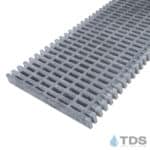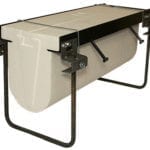TDS Drainage Glossary
Fiber-Reinforced Polymer (FRP)
Pultrusion is a forming process for converting reinforced fibers and resin into fiber-reinforced plastic, also known as fiber-reinforced polymer (FRP). FRP is up to 70% lighter than steel with an exceptional strength-to-weight ratio. FRP is corrosion-resistant, non-conductive, and requires less maintenance. Fiberglass grating is available individually, in frame and grate kits, or in custom sizes. Click here if you are interested in a custom quote.

Fiberglass Grating
Fiberglass grates are made of reinforced plastic material with embedded glass fibers. They are created with a forming process known as pultrusion, also known as fiber-reinforced polymer (FRP). FRP is up to 70% lighter than steel with an exceptional strength-to-weight ratio. FRP is corrosion-resistant, non-conductive, and requires less maintenance. Fiberglass grating is available individually, in frame and grate kits, or in custom sizes. Click here if you are interested in a custom quote.
Filter
Some catch basins offer fabric filters that facilitate seasonal maintenance. The filters keep lawn debris from building up and blocking water flow. They are designed so that the grate can be lifted to access the filter which can then be emptied, rinsed, and replaced.
Flanged Bell
Some drainage systems such as the pre-sloped FP1200 trench drain system have flanged bells at the joints to allow one channel to easily rest upon the other. One end is expanded out while the opposite end is straight and connects to the next consecutive channel. FP1200 is available for purchase in kits or through a project quote exclusively through Trench Drain Systems.
Floor Drain
Floor Drain has a broad range of meanings in the industry. It can refer to gutter drains that are a simple narrow trench lining a basement wall, a point drain or catch basin typically located in the center of a room, or a trench drain system complete with grates. The purpose of floor drains is to divert or redirect water in order to keep the space free of pooling water.
Flow Area
Flow area refers to the openings in the trench drain grate where the runoff flows. Determining the flow area for grates is an important project consideration. Larger openings allow for faster water removal but can create hazards for pedestrians and bicyclists. Smaller openings can be heel-proof, ADA compliant, and prevent lawn debris from entering the trench drain system but can also become blocked and cause flooding if not properly maintained.
Flow Capacity
Flow capacity is a measure of how efficiently liquid flows through an area. Many projects with trench drain systems are specified based on a formula that helps to determine the Gallons per Minute (GPM) of the runoff. The amount of anticipated runoff, regional weather patterns (when applicable), and the amount of permeable and non-porous surface areas are all factors that determine the necessary flow capacity of the trench drain system needed. Click here for our experts to help you determine the right system for your project.
Flow Rate
Flow rate is also known as Gallons Per Minute (GPM). It is a measure of how many gallons of water should flow per minute. Most trench drain systems have a GPM associated with their specifications. However, project planners also need to consider the diameter and placement of the outlet which can dramatically impact the flow rate. Click here for our experts to help you determine the right system for your project.
Forklift Rating
Trench drain systems are chosen based on traffic weight and load class ratings. Forklift rating, in this instance, refers to the system being able to hold a rolling weight of over 89,000 pounds. Keep in mind that the weight distribution for forklifts with solid vs. air-filled tires is different. Also, factor in the potential weight that the forklift will be moving.
Load Class refers to the weight of the moving traffic that will be crossing the trench drain system. For example, Load Class A refers to pedestrian traffic while Load Class F is related to highway and jetliner airport traffic. Keep in mind that the word ‘moving’ traffic is important. If you are planning a project that will have standing weight on a system, ensure that the grate and channels are able to handle the stationary weight. Click here to view a Load Class chart.
Forming Systems
There are methods by which contractors may choose to create drainage channels. Some may form the channels using wood panels while others may choose to use commercially produced trench formers. Trench formers are one of two types commercially made of poured-in-place concrete trench drains. Trench forming systems use frame grates and a disposable pre-sloped form used to mold the concrete to form the drain channel. The other type of poured channels involves frame and grate systems that require a contractor to build the trench form that usually consists of a wood structure. Frame and grate systems can be made of a variety of materials including fiberglass. They provide a DIY trench drain system that allows flexibility in the width, depth, and slope of the channels. Click here to view install instructions for a fiberglass frame and grate system.

